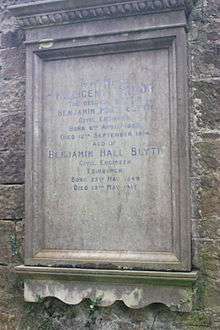Benjamin Blyth II
| Benjamin Blyth II | |
|---|---|
 | |
| Born |
25 May 1849 Edinburgh |
| Died |
13 May 1917 (aged 67) North Berwick, East Lothian |
| Nationality | Scottish |
| Education | Edinburgh University |
| Spouse(s) | Millicent Taylor |
| Children | Benjamin Edward Blyth, Elsie Winifred Blyth |
| Parent(s) | Benjamin Hall Blyth I, Mary Dudgeon Wright |
|
Engineering career | |
| Discipline | Civil |
| Institutions |
Institution of Civil Engineers (president), Royal Society of Edinburgh (fellow) |
| Practice name | Blyth and Blyth |

Benjamin Hall Blyth FRSE (25 May 1849 – 13 May 1917), often called Benjamin Blyth II, was a Scottish civil engineer.[1]
Life
Blyth, who was born in St Cuthbert's Parish, Edinburgh,[2] was the eldest of the nine children of the railway engineer Benjamin Blyth[1] and Mary Dudgeon Wright. He studied at Merchiston Castle School between 1860 and 1864 before studying for a Master of Arts degree from Edinburgh University, graduating in 1867.
After the death of both parents – Benjamin Blyth in 1866 and Mary Dudgeon Wright in 1868 – Blyth and his siblings were brought up by their mother's sister, Elizabeth Scotland Wright.[3][4]
Following his father's death Blyth entered the family engineering consultancy and became a partner five years later. Blyth served as a consultant to the North British Railway and the Great North of Scotland Railway and served in an advisory capacity to the British Army with the rank of Lieutenant-Colonel in the Engineer and Railway Staff Corps. In 1872 he married Millicent Taylor [5] with whom he had a son, Benjamin Edward, who died in infancy,[6] and a daughter, Elsie Winifred.[1] He became a member of the Institution of Civil Engineers in 1877, being elected to its council in 1900. He served as vice-president in 1911 and in 1914 became the first practising Scottish engineer to serve as president.[7] On 7 February 1898 he became a Fellow of the Royal Society of Edinburgh.[8]

In later life he lived in a large Victorian townhouse at 17 Palmerston Place in Edinburgh's West End.[9]
Blyth stood as the Unionist candidate for the East Lothian by-election of 1911. He lost. One of his platforms was opposing the giving of home rule to Ireland.[10]
He was widowed on 12 September 1914 and died in North Berwick on 13 May 1917, of "spittielioma of tongue".[11] He was survived by his daughter. His nephew, Benjamin Hall Blyth (sometimes referred to as Benjamin Blyth III) was the son of his brother Francis Creswick Blyth – who was taken on by Blyth and Blyth in 1909,[12] continued the consultancy after his death.[1]
He is buried on the obscured southern terrace of Dean Cemetery in Edinburgh, towards the east. His wife, Millicent Taylor (1852-1914) lies with him. Their infant son, Benjamin Edward Blyth, who died in 1875 aged only 6 weeks lies at their feet.
References
- 1 2 3 4 Dictionary of Scottish Architects entry
- ↑ Old Parish Record of birth
- ↑ Will of Mary Dudgeon Wright, held by Scottish records
- ↑ Census of Scotland 1871
- ↑ http://www.royalsoced.org.uk/cms/files/fellows/biographical_index/fells_indexp1.pdf
- ↑ Blyth, E.L.I. 1893, The family of Blythe or Blyth of Norton and Birchet
- ↑ Watson, Garth (1988), The Civils, London: Thomas Telford Ltd, p. 252, ISBN 0-7277-0392-7
- ↑ Royal Society of Edinburgh fellows list Archived 4 October 2006 at the Wayback Machine.
- ↑ Edinburgh and Leith Post Office Directory 1905-6
- ↑ The Scotsman, various editions from 1911
- ↑ Death certificate, held by Scottish records office
- ↑ Blyth and Blyth: The First 100 Years, historical records held by company
| Professional and academic associations | ||
|---|---|---|
| Preceded by Anthony George Lyster |
President of the Institution of Civil Engineers November 1914 – November 1915 |
Succeeded by Alexander Ross |